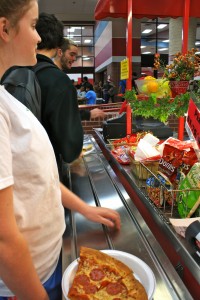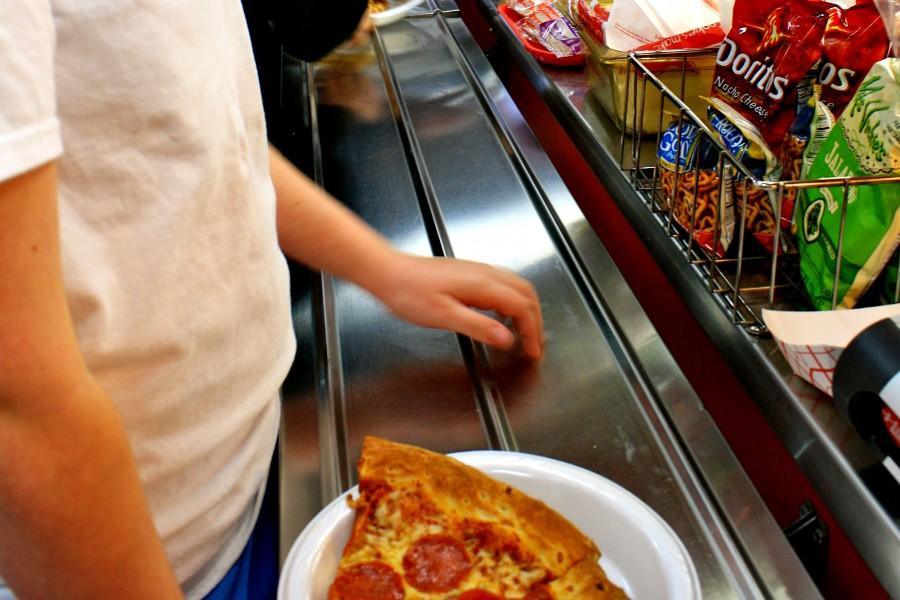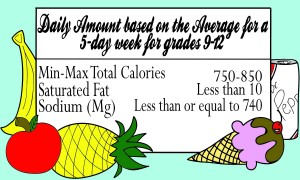The truth behind school food
December 21, 2012
Each day at 11:12 a.m. the first round of Coppell High School students head to the cafeteria. It happens again at 11:47 a.m. and once again at 12:22 p.m.
Students either wait for food in one of the seven lines or head to their lunch tables. They eat their lunch, both bought and brought, but do not think much about the lunch food they are eating.
“I bring my lunch every day because I don’t have to wait in line, it’s healthier and school food is not that great,” sophomore Adrian de le Garza said.
Many students share the same general opinion that school food is unhealthy, not fresh and overpriced.
“I have no idea how many calories or fat is in the school food, but my opinion of school food is just stereotypical, gross food,” senior Ashley Dicken a daily buyer of school lunches, said. “I wish they had more of healthier options. I get sick of the salad and sandwiches. Plus, it’s just hard to eat healthy when there’s a large cart of pizza in the middle of the cafeteria.”
CHS sells plenty of items that are generally classified as unhealthy such as pizza, candy, Otis Spunkmeyer cookies and fries. Students can buy as many of these foods as they want, and choose whatever food to buy. This does not particularly go along with United States Department of Agriculture (USDA) guidelines.
If a student were to buy as much of the Cici’s pepperoni pizza (per slice 160 calories and 370 mg sodium) as they wanted, they would be over the USDA max sodium after two slices and  over the daily calorie limit after five slices. The reason that CHS is allowed to do this is because the government does not fund food for the school. This eliminates all the USDA guidelines most schools have to abide by, but even so, the school does try to keep the meals as healthy as possible.
over the daily calorie limit after five slices. The reason that CHS is allowed to do this is because the government does not fund food for the school. This eliminates all the USDA guidelines most schools have to abide by, but even so, the school does try to keep the meals as healthy as possible.
“We make the salads and sandwiches fresh every single day. We get all of our produce from a farm once a week. We do not fry anything except the shrimp poppers,” CHS cafeteria manager Gina Honza said. “The traditional meals are where we try to keep the menu a balanced meal, but even then it really depends on the student to choose what they get or do not get in the line.”
As for freshness, the speculation about school food not being fresh can be dispelled to a certain extent.
“We are very strict as to how long we can keep leftovers,” Honza said. “Most foods we can keep for only six days. After that, we must throw them out. We have to label everything. For reheating, we can only reheat things once and after that, any other leftovers must be thrown out. There are some things that we can keep longer like the spaghetti sauce we can keep frozen for up to one month, but no longer than that.”
The unawareness of these facts in regards to freshness and especially unhealthiness has driven away many students from school lunches.
The major trend found between students who buy and bring their lunch seems to be between whether or not they try to eat healthy either due to personal convictions or parental convictions.
“I feel decently healthy eating school food, but I don’t try to eat healthy. And I buy food when I don’t have anything to bring for lunch,” counselor John Crook said.
For people like Crook, the health of school food does not really matter. But to others, it can be a large deterrent.
“I need to eat healthy because if I don’t I will probably throw up in football,” junior Nick Hruby said. “Also my mom makes my lunch because she wants me to eat healthy and not eat the school food.”
Convenience is also another large factor.
“I don’t buy lunch because I don’t like to wait in the long lines,” junior Holly Swaldi said.
Strange enough, the lines are not that long. During the beginning rush, the lines are only about 30 people deep and they go by fairly quickly. Plus only about 140-190 traditional meals are sold per lunch. That is a tiny amount considering how many students there are about 3000 students at CHS.
As for pizza, lines are longer and reach a larger population. Even then, the stats show how much of the CHS population bring their lunch. About 700 slices of pizza are sold per day keeping in mind that most times student buy more than one slice, thus making the amount around 350 students per day.
The preparation and nutrition of school food has been a mystery for a long time to many students. And delving deeper into the mystery some facts found can be seen surprisingly pleasing such as the freshly made salads and sandwiches or the only six day leftover time.
“[School food] is not the best in the world, but the improvement from since I was in school has been 1,000 percent,” Honza said.










